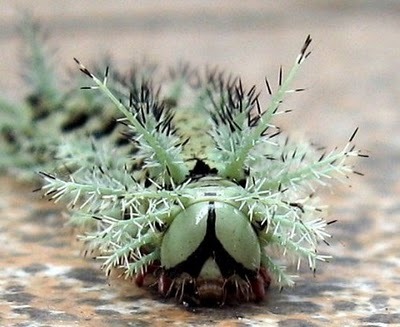
And this is what it does to a person..

Lonomia obliqua (or Giant Silkworm Moth, a name also used for a wide range of other Saturniid moths) is a species of Saturniid moths from South America. Its famous for its larvae form, rather than the adult moth, for several reasons. Recently announced in an episode of the Discovery Channel, known as the “assassin caterpillar,” this caterpillar has a spine-covered back filled with venom, and has been responsible for several deaths, especially in southern Brazil. This caterpillar has also been in numerous medical studies.
These caterpillars are about 4.5 -5.5 cm (about 2 in.) in length, with background colors ranging from green to brown. Well camouflaged, they have rows of tubercles crowned with whorls of easily detachable spines of different sizes.
As an article by Antonio Pinto stated, the Lonomia obliqua has a very unique venom that causes disseminated intravascular coagulation and a consumptive coagulopathy, which can lead to a hemorrhagic syndrome. It was soon discovered that at the base of each spine was a sack where the toxins were stored. As the stems and needles were stuck into the victim, venom would flow through the hollow needles and into the puncture wound.
It was also discovered that the toxin in this creatures skin held one of the strongest anti-clotting agents ever found in nature. This anti-clotting agent would attach with another protein to the body’s cells and cause them to leak as blood is unable to clot. This internal bleeding would fill the surrounding tissue with “bruised blood.” This internal bleeding spreads through the internal organs and eventually leads to compression and brain death. This accounts for the minimum of 500 deaths as a result of contact with Lonomia. Interestingly enough, the poison only takes effect in large amounts. In order to feel the extreme injuries caused by this creature, the victim would need at least 20 to 100 hundred stings.
The genus Lonomia includes 26 species found on the American Continent. However, only Lonomia obliqua and Lonomia achelous have caused severe accidents, leading to hemorrhagic syndrome. Since 1989 the number of human accidents caused by these caterpillars has been increasing in the southern region of Brazil. Most victims were male (63%), many were between 0 and 19 years old (45%), and lesions are especially common on the hands (38%). The reported death rate is 2.5%. An antiserum is produced by the Butantan Institute in São Paulo, Brazil. It effectively reverses the coagulation disorders induced by Lonomia obliqua venom, and patients treated with this antiserum recover rapidly.
Walang komento:
Mag-post ng isang Komento